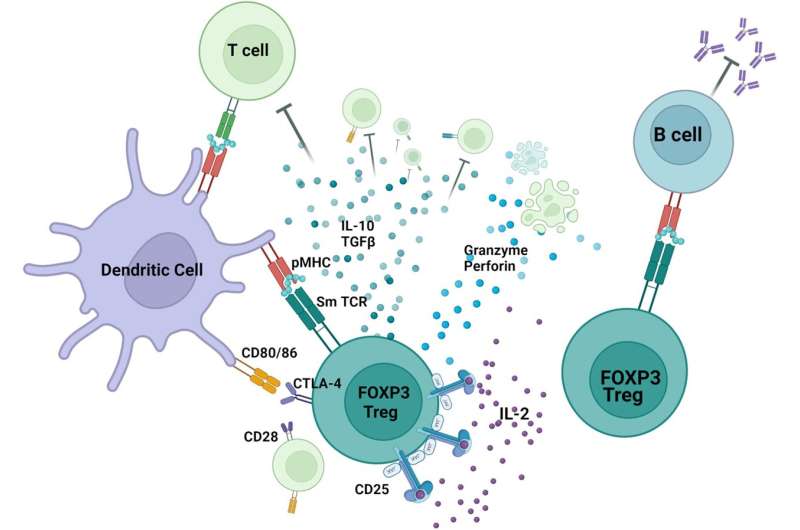This article has been reviewed according to Science X's editorial process and policies. Editors have highlighted the following attributes while ensuring the content's credibility:
fact-checked
trusted source
proofread
World-first discovery may enable an effective long-term lupus treatment

Australian researchers have worked out how to fix a defect that causes lupus, and hope their world-first discovery will offer effective long-term treatment.
Published
in Nature Communications, the Monash University-led study found a way to reprogram the defective cells of
Using human cells, the new treatment restores the protective side of the immune system that prevents autoimmunity, which is when the immune system attacks its own cells. The findings relate to the autoimmune disease lupus, a debilitating disease with no cure and limited treatments.
But researchers hope this new method, developed in test tubes and proven in pre-clinical models, can also be developed for other autoimmune diseases such as diabetes, rheumatoid arthritis, and multiple sclerosis.
Humans all have proteins that the immune system could attack, but this doesn't happen in healthy people because of special cells called "regulatory T cells" or "T-regs" that protect from autoimmune disease. These are lacking in people who develop lupus and other autoimmune conditions.
Co-senior author Associate Professor Joshua Ooi, who heads Monash University's Regulatory T Cell Therapies Group based at Monash Health, said the therapeutic effect was achieved by identifying specific protective molecules from healthy people and reprogramming ineffective lupus patient T-regs to restore their ability to switch off unwanted immune responses.
"We showed the effectiveness of this approach using human lupus patient cells, both in the test tube and in an experimental model of lupus kidney inflammation," Associate Professor Ooi said.
"We were able to completely arrest the development of lupus kidney disease, without the use of the usual non-specific and harmful immunosuppressant drugs. It's like a reset of the abnormal immune system back to a healthy state—kind of like a major software upgrade. That it uses the patient's own cells is a very special part of this."
About one in 1,000 Australians has lupus, and rates are higher in First Nations communities. Nine in 10 people with lupus are female and most develop it aged 15–45.
Co-senior author Professor Eric Morand, who is Dean of Monash University's Sub Faculty of Clinical & Molecular Medicine and founded the Monash Lupus Clinic, described the treatment's effectiveness as "profound" and a "game-changer."
Study patients are managed at Monash Health, where Professor Morand is Director of Rheumatology. He said the research team was now designing clinical trials expected to start in 2026 to investigate whether this method was a long-term cure for people with lupus.
"The ability to target, specifically, the disease-causing immune defect, without the need to suppress the entire immune system, is a game-changer," he said. "Even if the effects are only medium term, we are confident the treatment can be easily repeated as needed."
Associate Professor Ooi previously discovered that a lack of specific T-regs to stop the immune system from targeting the body can lead to autoimmune disease. The new treatment would involve taking blood cells from the lupus patient, modifying them in the lab to restore this protective effect, then giving them back.
"This project relied on the generous involvement of patients, which enabled us to use human lupus cells every step of the way," Associate Professor Ooi said. "This allows us to work as close to the human disease as possible in the lab.
"This is a unique characteristic of Monash University—state-of-the-art research labs side-by-side with clinicians and patients, in this case at Monash Health."
Co-first authors Peter Eggenhuizen, a Ph.D. candidate and Research Fellow with the Center for Inflammatory Disease Monash University, and Dr. Rachel Cheong, former Ph.D. candidate at the Center for Inflammatory Disease Monash University, are confident the new method can be developed for up to 100 other autoimmune diseases such as diabetes, rheumatoid arthritis, multiple sclerosis, Sjögren's syndrome, scleroderma, and myasthenia gravis.
"This breakthrough offers huge hope not only in lupus but across the spectrum of autoimmune diseases," Mr. Eggenhuizen said. "There is a huge range of autoimmune diseases that could be targeted with this approach."
Dr. Cheong added, "The great thing is that because the treatment is very specific, it doesn't harm the rest of the immune system. However, this means that the treatment needs to be carefully developed disease-by-disease, as each one is distinct."
More information: Peter J. Eggenhuizen et al, Smith-specific regulatory T cells halt the progression of lupus nephritis, Nature Communications (2024). DOI: 10.1038/s41467-024-45056-x
















